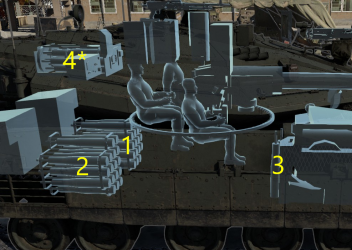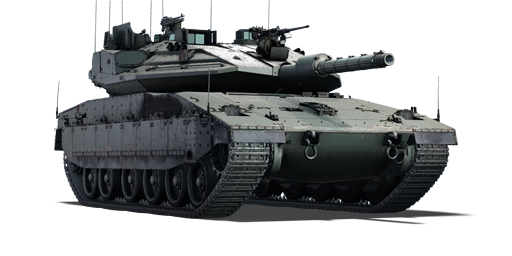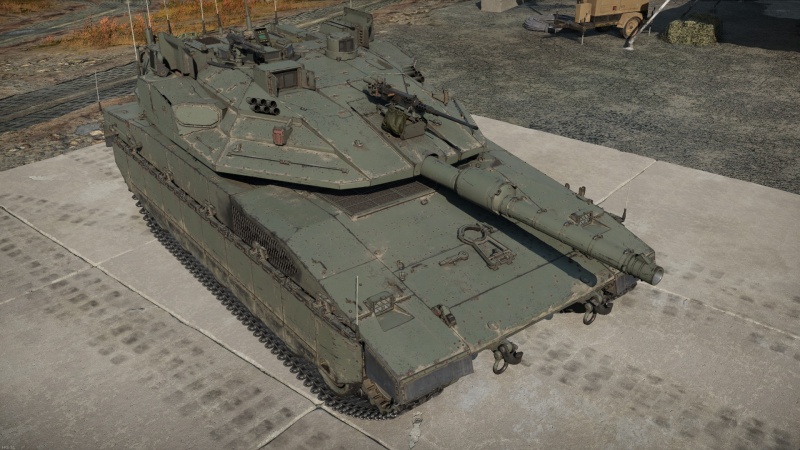Difference between revisions of "Merkava Mk.4M"
(→Main armament: Updated) |
m (→Pros and cons) (Tag: Visual edit) |
||
| Line 140: | Line 140: | ||
* Engine is at the front of the tank and any penetrating hit to the UFP will result in a stranded tank | * Engine is at the front of the tank and any penetrating hit to the UFP will result in a stranded tank | ||
* Upper front plate is weaker than those of other nations' tanks | * Upper front plate is weaker than those of other nations' tanks | ||
| − | * Slower reload than most top tier manual loaded tanks. 8 | + | * Slower reload than most top tier manual loaded tanks. 7.8 secs stock, 6.0 ace. |
* depression of only 7° | * depression of only 7° | ||
Revision as of 22:45, 7 July 2024
| This page is about the Israeli medium tank Merkava Mk.4M. For other versions, see Merkava (Family). |
Contents
Description
The Merkava Mk.4M is the third and last subvariant of the Merkava Mk.4, which is the fourth variant of the Merkava main battle tank family. It is an enhanced subvariant of the standard Merkava Mk.4, outfitted with the Trophy active protection system (APS). Also known as the Merkava Mk.4M Windbreaker, this tank began production in 2009. In 2011, the first brigade outfitted with these tanks was declared operational. It saw action in the same year and successfully resisted an anti-tank guided missile (ATGM) attack. Since then, the updated Merkava Mk.4M tanks equipped with the Trophy APS have intercepted dozens of rocket-propelled grenades (RPGs) such as the RPG-29 and ATGMs such as the Kornet and Metis-M.
Introduced in Update "Wind of Change", the Merkava Mk.4M is the ultimate subvariant of the Merkava Mk.4. Players can lead assaults into modern battlefields without fear of ATGMs from both ground vehicles and helicopters, thanks to the Trophy APS. The Merkava Mk.4M is a truly modern main battle tank designed for even the most intense conflict, providing the finest protection and firepower to confront any adversary. Players should bear in mind, however, that the Trophy APS does not give unlimited protection, and hence the tank should not stay out in the open for long during combat.
General info
Survivability and armour
Describe armour protection. Note the most well protected and key weak areas. Appreciate the layout of modules as well as the number and location of crew members. Is the level of armour protection sufficient, is the placement of modules helpful for survival in combat? If necessary use a visual template to indicate the most secure and weak zones of the armour.
Armour type:
| Armour | Front (Slope angle) | Sides | Rear | Roof |
|---|---|---|---|---|
| Hull | ___ mm | ___ mm Top ___ mm Bottom |
___ mm | ___ - ___ mm |
| Turret | ___ - ___ mm Turret front ___ mm Gun mantlet |
___ - ___ mm | ___ - ___ mm | ___ - ___ mm |
| Cupola | ___ mm | ___ mm | ___ mm | ___ mm |
Notes:
Mobility
| Game Mode | Max Speed (km/h) | Weight (tons) | Engine power (horsepower) | Power-to-weight ratio (hp/ton) | |||
|---|---|---|---|---|---|---|---|
| Forward | Reverse | Stock | Upgraded | Stock | Upgraded | ||
| Arcade | 72 | 72 | 65.5 | 2,325 | 2,862 | 35.5 | 43.69 |
| Realistic | 65 | 65 | 1,327 | 1,500 | 20.26 | 22.9 | |
Modifications and economy
Armaments
Main armament
| 120 mm IMI MG251 | Turret rotation speed (°/s) | Reloading rate (seconds) | |||||||||||
|---|---|---|---|---|---|---|---|---|---|---|---|---|---|
| Mode | Capacity | Vertical | Horizontal | Stabilizer | Stock | Upgraded | Full | Expert | Aced | Stock | Full | Expert | Aced |
| Arcade | 46 | -7°/+20° | ±180° | Two-plane | 32.4 | 44.8 | 54.4 | 60.2 | 64.0 | 7.80 | 6.90 | 6.36 | 6.00 |
| Realistic | 20.2 | 23.8 | 28.9 | 32.0 | 34.0 | ||||||||
Ammunition
| Penetration statistics | |||||||
|---|---|---|---|---|---|---|---|
| Ammunition | Type of warhead |
Penetration @ 0° Angle of Attack (mm) | |||||
| 10 m | 100 m | 500 m | 1,000 m | 1,500 m | 2,000 m | ||
| M325 | HEATFS | 480 | 480 | 480 | 480 | 480 | 480 |
| M339 | HE-TF | 65 | 65 | 60 | 58 | 53 | 50 |
| M322 | APFSDS | 589 | 586 | 577 | 565 | 553 | 541 |
| M338 | APFSDS | 611 | 608 | 597 | 585 | 573 | 560 |
| Shell details | ||||||||||||
|---|---|---|---|---|---|---|---|---|---|---|---|---|
| Ammunition | Type of warhead |
Velocity (m/s) |
Projectile mass (kg) |
Fuse delay (m) |
Fuse sensitivity (mm) |
Explosive mass (TNT equivalent) (kg) |
Ricochet | |||||
| 0% | 50% | 100% | ||||||||||
| M325 | HEATFS | 1,078 | 15.81 | 0.05 | 0.1 | 2.36 | 65° | 72° | 77° | |||
| M339 | HE-TF | 900 | 17 | 1.5 | 3 | 3.66 | 79° | 80° | 81° | |||
| M322 | APFSDS | 1,705 | 5.6 | - | - | - | 78° | 80° | 81° | |||
| M338 | APFSDS | 1,680 | 5.06 | - | - | - | 78° | 80° | 81° | |||
Ammo racks

| Full ammo |
1st rack empty |
2nd rack empty |
3rd rack empty |
4th rack empty |
Visual discrepancy |
|---|---|---|---|---|---|
| 46 | 30 (+16) | 13 (+33) | 11 (+35) | 1 (+45) | No |
Machine guns
| 12.7 mm M2HB | ||||
|---|---|---|---|---|
| Mount | Capacity (Belt) | Fire rate | Vertical | Horizontal |
| Coaxial | 1,000 (200) | 575 | - | - |
| 7.62 mm FN MAG 60-40 | ||||
|---|---|---|---|---|
| Mount | Capacity (Belt) | Fire rate | Vertical | Horizontal |
| Coaxial | 6,000 (200) | 960 | - | - |
| Pintle | 1,800 (200) | 960 | -5°/+50° | -60°/+120° |
Usage in battles
Describe the tactics of playing in the vehicle, the features of using vehicles in the team and advice on tactics. Refrain from creating a "guide" - do not impose a single point of view but instead give the reader food for thought. Describe the most dangerous enemies and give recommendations on fighting them. If necessary, note the specifics of the game in different modes (AB, RB, SB).
Pros and cons
Pros:
- Powerful APFSDS round
- Trophy System will stop most missiles
- HE-TF can help with fighting against helicopters
- Generation 2 thermal for gunner and commander
- 200mm of NERA on the turret roof will protect against HE shells striking the optics and sometimes even against artillery
- 400mm of NERA side armor above the tracks. Enough to stop most HEAT-FS and autocannons.
- Can reverse at 64kph.
Cons:
- Engine is at the front of the tank and any penetrating hit to the UFP will result in a stranded tank
- Upper front plate is weaker than those of other nations' tanks
- Slower reload than most top tier manual loaded tanks. 7.8 secs stock, 6.0 ace.
- depression of only 7°
History
Due to the relatively small size of the Israeli Defense Force (IDF) compared to some of its potential opponents, Israel's military doctrine is ever focused on protecting its highly-trained personnel from harm during combat. This is typically achieved by fielding advanced technology designed to reduce casualties. Nowhere is this seen more clearly than in the design of the Merkava tank. Beyond its rare configuration, which places the engine at the front to soak up penetrating rounds, as well as the "Hairs of Shulamit" passive protective chains around the rear of the tank's turret, in the early 2000s Israel began simultaneous development of two Active Protection Systems (APS) designed to intercept and destroy incoming anti-tank weaponry.
One of these two systems is called "Me'il Ruach" (Windbreaker Jacket, or simply Windbreaker), which was developed by Israel's Rafael Advanced Defense Systems. The Windbreaker system contains a high-precision radar and four flat-panel antennas, designed to detect incoming projectiles such as HEAT rounds, ATGMs, RPGs, and any other "slow" chemical warheads. Once an incoming projectile is detected, the system quickly calculates its exact flight trajectory and determines the optimum timing for interception. Two launchers on either side of the turret can quickly rotate in any direction to fire a pack of Explosively-Formed Projectiles (EFP) at the warhead and detonate it before it can hit the tank. This is effectively a very tight shotgun blast of tiny pellets that triggers the warhead by directly hitting it. If the system determines that the enemy projectile will not hit the tank, it does not fire the pellets at all.
The extreme accuracy of the radar, the precise trajectory calculation and the tight cone of pellets not only increase the chance of detonating the warhead to approximately 90-95% (100% in operational history), but also significantly reduce the risk to any friendly infantry who may be near the tank when the system fires. This was set as a prerequisite before development ever began. Furthermore, the system alerts the tank crew to the direction the attack came from, allowing them to return fire quickly and effectively.
The Windbreaker system was first installed onto a platoon of operational Merkava Mk.4 tanks in 2009. The upgraded model was renamed Merkava Mk.4M, with the M being the first letter in the system's Hebrew name ("Me'il Ruach"). The IDF's 401st Armored Regiment was the first to be fully equipped with Merkava Mk.4Ms in 2012. Today, all new Israeli-produced tanks are Merkava Mk.4Ms; all Merkava Mk.4 tanks in service in the IDF have been upgraded to Merkava Mk.4M standards; and the Windbreaker system is also known to feature on some older Merkava Mk.3D models.
Windbreaker became the first fully-operational hard-kill APS in any Western-aligned army, and to this day is the only mass-produced system of this type outside of Russia and China. It was first tested in battle in 2011, when it intercepted an RPG fired by Hamas combatants at a Merkava Mk.4M on the border of the Gaza Strip. During Operation Protective Edge in 2014, Windbreaker systems reportedly intercepted a total of 15 enemy warheads, including Metis, Konkurs and Kornet ATGMs. As of 2023, the system has maintained a 100% operational success rate in combat.
Windbreaker's development quickly drew the attention of the United States Army, which first purchased a light version of the system for protecting its Oshkosh M-ATVs. In the United States military, the system is named "Trophy". In 2017, the U.S. Army ordered 100 heavy-model Trophy units for installation on M1A2 Abrams tanks, enough to outfit an entire regiment. In 2019 the Army ordered enough systems to outfit three additional regiments. Germany was also an early adopter of the Trophy system, installing it into its state-of-the-art Leopard 2A7A1. Reportedly, the British army is currently planning on installing the Trophy system into its future Challenger 3 tank, though trials are proceeding concurrently for other APS systems.
Media
- Skins
- Videos
See also
Links to the articles on the War Thunder Wiki that you think will be useful for the reader, for example:
- reference to the series of the vehicles;
- links to approximate analogues of other nations and research trees.
External links
| Israeli Ordnance Corps (חיל החימוש) | |
|---|---|
| Medium Tanks | M-51 · M-51 (W) |
| MBTs | |
| Magach | Magach 1 · Magach 2 · Magach 3 · Magach 3 (ERA) · ▃Magach 3 (ERA) · Magach 5 |
| Magach 6 · Magach 6A · Magach 6B · Magach 6C · Magach 6R · Magach 6M · Gal Batash | |
| Sho't | Sho't · Sho't Kal Alef · Sho't Kal Gimel · Sho't Kal Dalet · ▄Sho't Kal Dalet |
| Tiran | Tiran 4 · Tiran 4S |
| Merkava | ▃Merkava Mk.1 · Merkava Mk.1B · Merkava Mk.2B · ▃Merkava Mk.2B · Merkava Mk.2D |
| Merkava Mk.3B · Merkava Mk.3C · ▃Merkava Mk.3D · Merkava Mk.4B · Merkava Mk.4M | |
| Tank destroyers | Zachlam Tager |
| See Also | Chrysler Defense · Department of Tank Design · Morozov Design Bureau |
| Israel medium tanks | |
|---|---|
| M-51 | M-51 · M-51 (W) |
| Magach | Magach 1 · Magach 2 · Magach 3 · Magach 3 (ERA) · Magach 5 · Magach 6 |
| Magach 6A · Magach 6B · Magach 6B Gal · Gal Batash · Magach 6C · Magach 6M · Magach 6R · Magach Hydra · Magach 7C | |
| Tiran | Tiran 4 · Tiran 4S · Tiran 6 |
| Sho't | Sho't · Sho't Kal Alef · Sho't Kal Gimel · Sho't Kal Dalet |
| Merkava | Merkava Mk.1B · Merkava Mk.2B · Merkava Mk.2D · Merkava Mk.3B · Merkava Mk.3C · Ra'am Sagol |
| Merkava Mk.4B · Merkava Mk.4M · Merkava Mk.4 LIC | |
- Ground vehicles
- Israel ground vehicles
- Eighth rank ground vehicles
- Medium tanks
- Ground vehicles with composite armour
- Ground vehicles with smoke grenades
- Ground vehicles with engine smoke generating system
- Ground vehicles with night vision device
- Ground vehicles with thermal sight
- Ground vehicles with gun stabilizer
- Ground vehicles with active protection system





